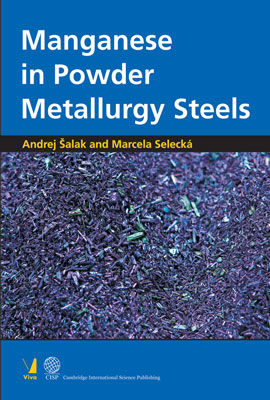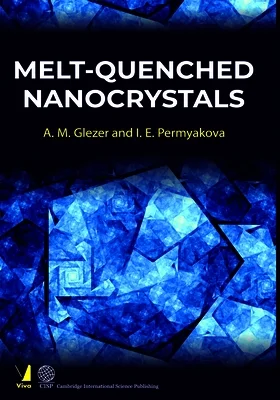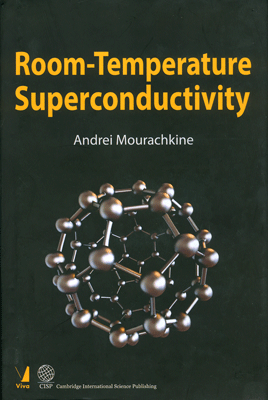
Manganese in Powder Metallurgy Steels
Manganese in Powder Metallurgy Steels
₹2,065.50 ₹2,295.00 Save: ₹229.50 (10%)
Go to cartISBN: 9788130922973
Bind: Hardbound
Year: 2017
Pages: 454
Size: . mm
Publisher: Cambridge International Science Publishing
Published in India by: Viva Books
Exclusive Distributors: Viva Books
Sales Territory: India, Nepal, Pakistan, Bangladesh, Sri Lanka
Description:
The monograph introduces the data about the mechanical properties of sintered manganese steels published since 1948 up to the present time. The effect of all possible material, alloying and sintering factors on the properties of manganese steels which are in most cases on the level of those alloyed with nickel is discussed. The sintering of the steels was successfully carried out under laboratory and industrial conditions not fulfilling the thermodynamic requirements for the Mn?O system. The reduction ? (self cleaning) effect of manganese vapour for the sintering atmosphere formed by sublimation due to manganese high vapour pressure is presented as the only possible mechanisms under which the sintering of manganese-containing steels takes place. It is stated conclusively that sintering under this mechanisms occurs without demanganization and decarburization of the compacts in the atmosphere with the low dew point contrary to that with a high dew point adversely affecting the sintering and alloying process.
In this book:
- Thermodynamic conditions for the Mn?O system in sintering of manganese steels
- Alloying and sintering of manganese steels in terms of high manganese vapour pressure
- Alloying and sintering of manganese steels by manganese vapour
- Effect of base materials and of various processing methods on mechanical and some special properties of manganese steels
- Effect of additional elements on the properties of manganese steels
- Properties of sintered and powder forged steels based on prealloyed powders
- Processing and properties of hybrid Fe?(Cr)?xMn?(Mo)?(V) steels
- Basic characteristics of manganese steels from the year 1948
- Effect of variable processing conditions and materials on properties of sintered MnC steels
- Effect of processing conditions and materials on properties of sintered Fe, Cr, Mo, C steels containing manganese
- Sintering of manganese steels in low- and high-purity atmospheres: Results and evaluation
Contents:
Introduction 1 • Part I
Thermodynamic conditions for the Mn–O system in sintering of manganese steels • Manganese in steelmaking • Basic thermodynamic characteristics of protective atmospheres for sintering steels alloyed with manganese and other elements • Influence of protective atmospheres on proper sintering of carbon containing steels
Alloying and sintering of manganese steels in terms of high manganese vapour pressure • Vapour pressure of elements • Basic formulas characterising the sublimation of manganese from solid manganese • Effect of manganese vapour in laboratory sintering of Fe–Mn–C samples • Manganese sublimation and condensation in free space • Reaction of manganese vapour with porcelain • Summary
Alloying and sintering of manganese steels by manganese vapour • Microstructure formation • Conventional radiation sintering • Induction sintering • Nucleation of new grains in base iron powders in Fe–Mn materials • Sintering and alloying of manganese steels analysed by the dilatometric tests • Effect of base materials and processing variables • Effect of manganese on isothermal sintering and cooling process according to the dilatometric graphs • Enhancing effect of manganese in solid-state sintering • Effect of cooling rate on the transformation of austenite in sintered steels as indicated by dilatometric graphs
Effect of base materials and of various processing methods on mechanical and some special properties of manganese steels • Electrolytic manganese and ferromanganese grades - physical–metallurgical and technical characteristics • Ferromanganese grades • As milled characteristics of manganese carriers • Low-carbon low-alloy sintered steel • Mechanical properties • Microstructure and fracture • Properties of induction sintered and upset-forged manganese steels • Mechanical properties of induction sintered Fe–4.5Mn–0.33C steel • Microstructure • Mechanical properties of induction sintered and upset-forged Fe–4.5Mn–0.33C steel prepared on the basis of both iron powder grades • Effect of various material and processing conditions on mechanical and some specific properties of manganese steels • Effect of iron powder grades of markedly different structural activity and manganese addition on properties of sintered manganese steel • Effect of various hot forming processes on mechanical properties of manganese steels • Effect of manganese addition and of iron powder grade on friction properties • Friction and mechanical properties of sintered steels of various composition • Industrially sintered prototype structural parts prepared from manganese steel
Effect of additional elements on the properties of manganese steels • Effect of molybdenum • Properties of Fe–Mn–C steels with molybdenum addition • Manganizing of powder steels combined with sintering • Sintering of Fe–Mn–C and Fe–Mn–Mo–C steels in α-region and at 0°C • Effect of sintering temperature on properties of Fe–Mn–C, Fe–Cr–C and Fe–Mo–C steels • Effect of liquid phase forming elements on properties of Fe–Mn–C steels • Effect of copper • Effect of tin • Effect of phosphorus • Effect of boron • Effect of boron addition on properties of Fe–Mn–C steel • Effect of boron addition on tribological properties of Fe–Mn–C steels • Effect of boron addition on mixed low-alloyed Fe–Mn–Cr–Mo–C steels • Effect of boron addition on properties of Fe–Cr–Mo–V–(Mn) sintered steels • Manganese-assisted pack boriding of sintered steels • Sintering and pack boriding – two-stage process
Properties of sintered and powder forged steels based on prealloyed powders • Properties of sintered and powder forged steels based on prealloyed Fe–Cr–Mn–Mo–(V) powders with high oxygen content • Mechanical properties • Properties of powder forged steels based on idustrially produced chromium- and manganese-prealloyed powders of high oxygen content • Properties of powder forged steels based on commercial prealloyed Fe–Cr–Mn–Mo–V powders • Density and mechanical properties • Density • Development and manufacturing of rolIing bearing rings by powder forging of steels based on prealloyed Fe–Ni–Mo and Fe–Cr–Mn–Mo powders • Mechanical properties of powder forged steels based on prealloyed powders • Mechanical properties of PF steel based on Astaloy A powder • Contact fatigue endurance of powder forged steels based on prealloyed powders • Processing conditions and base characteristics of powder forged rolling bearing rings and their properties • Examination of powder forged bearing rings properties • Experimental equipment for atomisation of prealloyed Fe–Cr–Mn–Mo powders with low oxygen content
Processing and properties of hybrid Fe–(Cr)–xMn– (Mo)–(V) steels • Properties of hybrid steels based on prealloyed Fe–Cr–Mo–V powders • Mechanical and toughness properties and microstructure • Fractures of Fe–Cr–Mo–V–Mn–V steels • Processing and properties of hybrid Fe–Cr–Mo–xMn– C steels • Properties of Fe–3Cr–0.5Mo steel with manganese addition • Effect of manganese carrier on properties of hybrid Fe–Cr–Mo–xMn steels • Mechanical properties • Sintering at 1180°C • Sintered and sinter hardened hybrid steels • As sintered properties • Basic characteristics • As sinter hardened properties • Properties of hybrid Fe–Cr–0.5Mo–xMn–C steels sintered under industrial conditions • Basic characteristics • Mechanical properties • Microstructure and fracture • Microstructure • Effect of industrial sintering conditions on properties and microstructures of hybrid Fe–3Cr–0.5Mo–Mn–C steels • Properties of hybrid Fe–(0.85, 1.5)Mo–Mn–C steels • Properties of Fe–0.85Mo–xMn–0.3C steels • Properties of Fe–0.85Mo–Mn–0.5C steel • Mechanical properties after sintering at 1150°C • Properties of Fe–0.85Mo–xMn–0.6C steel • Properties of industrially sintered mixed and hybrid Fe–0.85Mo–xMn–C steels • Properties of sintered hybrid Fe–(1.5, 0.85)Mo–Mn–0.5C steels
Part II • Basic characteristics of manganese steels from the year 1948 • Thermodynamic and physical characteristics of chromium and manganese as alloying elements in powder metallurgy • Properties of sintered manganese steels studied in the initial stage • Starting knowledge about sintered manganese steels with high manganese and carbon contents • Processing conditions and properties of sintered austenitic manganese steels • High-alloyed sintered manganese steels • Alloying of manganese steels with master alloys • Alloying of manganese steels by master alloys in carbide form composed from elements with high oxygen affinity • Alloying of manganese steels by Fe–Mn–Si–C master alloy • Alloying of manganese steels by master alloys containing Cr and Mn • Liquid phase sintering of Fe–Mn steels • Liquid phase sintering of Fe–Mn steels through low-melting alloys • Alloying of manganese steels with atomised Mn–Cu and Mn–Ni master alloys
Effect of variable processing conditions and materials on properties of sintered Mn–C steels • Alloying with low-melting elements and sintering in high-purity atmospheres • Alloying with low-melting elements • Sintering of Fe–Mn–C steels in high-purity atmospheres • Effect of processing conditions on properties of manganese steels • Effect of iron powder and ferromanganese grades • Effect of sintering conditions • Effect of base powder grades • Effect of some processing conditions and of different materials • Effect of cooling rate • Effect of sintering conditions • Hardenability study • Effect of manganese on hardenability of prealloyed powders • Effect of tempering temperature • Sintering in semi-closed containers • Effect of manganese on microstructure formation • Dimensional changes of Fe–Mn–C steels • Effect of different processing variables on properties of Fe–Mn–C steels • Processing conditions and properties of sintered manganese steel for structural parts • Preparation of gear steel • Innovative processing of manganese steel gears • Mechanical properties of sintered manganese steel gears • Effect of Mn addition on strain micromechanism in as sintered L steel
Effect of processing conditions and materials on properties of sintered Fe, Cr, Mo, C steels containing manganese • Effect of different addition mode of molybdenum on properties of manganese steel • Effect of cooling rates on properties of Fe–Mn–Mo–C steels • Dimensional changes of the compacts based on plain iron powders with addition of prealloyed molybdenum powders and of manganese tested by dilatometry • Properties of diffusion-alloyed steels affected by manganese • Properties of industrially sintered Fe–Mn–Mo–C steels • Processing and properties of sintered Mn–Cr–Mo–C steels • Sinterability and hardenability of Mn–Cr–Mo steels • Processing and properties of hybrid sintered Mn–Cr–Mo–C steels • Properties of sintered 3Cr–0.5Mo steel promoted by manganese in form of liquid phase • Properties of hybrid Mn–Cr–Mo steels coated with hydrocarbons • Properties of sintered steels based on prealloyed Cr–Mo–Mn powders • Properties of high temperature sintered steels based on prealloyed Cr–Mo–Mn powders • Influence of sintering temperature on the properties of prealloyed PM steel containing Cr, Mo and Mn • Properties of manganese steels based on CrL and CrM prealloyed powders • Properties of sintered steels based on Cr and Cr–Mn prealloyed powders with various Cr and Mn content
Part III • Sintering of manganese steels in low- and high-purity atmospheres: Results and evaluation • Basic thermodynamic and physical characteristics of manganese in term of its use for alloying of sintered steels • Chemistry and mechanical properties of manganese containing steels sintered in H/N atmospheres with different dew points • Sintering of manganese steels in atmospheres with different ratios of H and N with dew points up to –60°C • Industrially sintered prototype structural parts prepared from manganese steel • Explanation of the sintering processes of manganese steels occurring in atmospheres with different partial pressure of oxygen • Crucial results • Overview of materials and processes for preparation of manganese-alloyed steels with the highest strength properties • Materials and processing conditions • Highest tensile (UTS) and transverse rupture strength (TRS) values of manganese-containing steels attained under corresponding conditions






